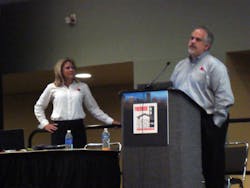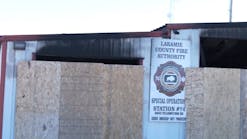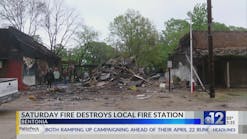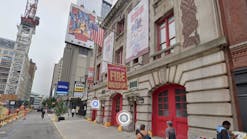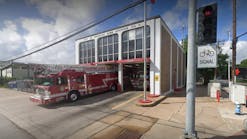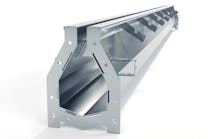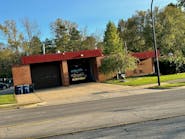BALTIMORE, Md. – One of the most important ingredients in the construction of a successful new fire station is finding the most appropriate site. While that’s not always possible, there are some attributes communities should look for when considering the construction of a new station.
Ray Holliday, architect/studio director for BRW Architects in College Station, Texas, and his colleague Jennifer Bettiol, presented a class called “Selecting a Site: Looking Under The Rocks” at Firehouse’s Station Design Conference, co-located with Firehouse Expo in Baltimore on Wednesday.
“What do you need when you build a fire station,” Holliday asked the audience of nearly 100 conference attendees. He got answers that ranged from money and more money to support of the citizens and politicians. He had another answer in mind.
“The cornerstone is the site,” Holliday said.
Holliday illustrated the importance of the site and knowing all about the land before making the purchase at the top of his presentation with a case study. On a projection slide, he showed a triangular piece of land that was encumbered by so many easements and flanked by major roads, it made the site almost unusable. The community got the land in a swap with a land developer, so the cost was virtually free.
“Be careful of free land,” Holliday said, noting it’s not always the best answer because of unending hidden factors. He added the three-acre parcel was reduced to less than one acre because of the easements and other constraints.
“You need to ask questions and learn about things like easements,” Holliday said.
As a rule of thumb, Holliday said, for every 5,000 square feet of fire station, the community should look for at least one acre of land. In this particular case, his firm had to squash a 13,000-square-foot station on less than an acre – a challenge that presented some drawbacks.
Bettiol said the characteristics of an ideal site is square or slightly rectangular that can accommodate a 35-foot turning radius for tandem axel apparatus. The site also needs at least a 15-foot apron straight in front of the station with a good “cone of vision” and plenty of visibility as the station entrance connects to the road.
She said fire departments also need to think carefully about the parking and double it for shift changes when double the amount of traffic is on site.
Even the orientation of the station on the site is critically important. Holliday said he likes to have buildings face north which reduces the low sunlight shining into the eyes of apparatus operators. The next preferred direction is South while East and West are equally bad decisions because of the Sun, Holliday said. A building facing north also improves the cross breezes in the building, he said.
Bettiol said departments also need to be careful of the kinds of soils on the site. Soft, sandy or loamy soils can mean the concrete might break over the years with heavy truck traffic pounding on it, she said.
Rock isn’t necessarily better because a lot of it might have to be blasted and removed at a huge expense.
Run off water is also something to be considered and the need to detain water on site, either with underground holding facilities, or surface detention ponds, Bettiol added.
Holliday said most sites have some issues, but it’s important to know what they are before any construction begins.
“We have yet to have the perfect site,” Holliday said. “All architects are challenged by it.”
Fire stations are public buildings, and they are required to meet the American’s With Disabilities Act mandates, Bettiol said, noting compliance will require space, especially for parking.
Some communities also have local ordinances protecting large “heritage trees,” Bettiol said. Those need to be considered when selecting a site, she said, noting one community had a rule that for every heritage tree that was cut down, 20 new trees had to be planted. She said one site required over $100,000 in landscaping to meet the community’s demands.
Departments should also avoid locating fire stations at major intersections for obvious reasons, she said.
“You want to be close to them, but not on them,” Bettiol said.
Fire departments should look for flat square sites, located to give the best ISO ratings, they said.
Stations located in residential portions of a community should blend into their surroundings as should those built in commercial areas, Bettiol said.
Both Holliday and Bettiol said a feasibility study is the best way to start with site selection. Bettiol said a $5,000 study is significantly less expensive than installing 100 piers on which to build a fire station just because the soils were not appropriate for the use.
Too often, Holliday said, communities settle on a site because it was free, or already owned, but free land is not always the best answer. The lot could be located in an area where security could be a problem as thefts often occur while firefighters are out on a call.
Or the land is contaminated and will cost a small fortune to clean up, Holliday said.
"I don’t take away anything from anyone who wants to take advantage of free land,” Holliday said, adding that an awareness of the attributes and pitfalls will help with the decision making process.
“The more successful stations start out with a feasibility study,” Bettiol said. “You are going to have the answers to the questions with the feasibility study.”
More from Firehouse Expo 2015:
- Picking The Right Fire Station Site Is Key
- Firefighters Hit the Street for Lesson
- Creating Green and Red Zones in Fire Stations
- Basement Fire Tactics Explained
- Sendelbach Asks 'Are You All In?'
- Harvey Eisner Remembered, Keynote Stresses Accountability
- FDNY’s Muschello Honored with Top Heroism Award at Firehouse Expo
- Photos: Firehouse Expo - Day 3
